Garmin 18″ HD radar, the beam width problem
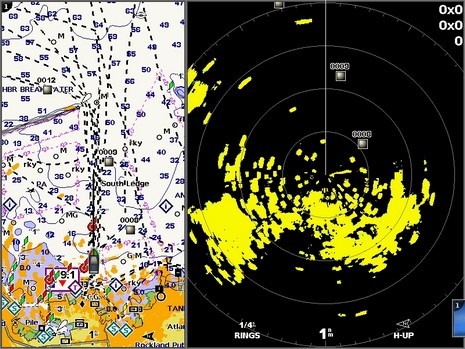
My first time out with the Garmin 18” HD radar was a bit disappointing; Rockland Harbor (try the ‘NOAA’ slider), loaded with bold shore features and boats, seemed overloaded with blotchy targets. It didn’t help that I’d recently been out in another small boat with a Furuno 3.5’ UHD open array that painted targets with astonishing accuracy, even without adjustments. But that’s not a fair comparison (aside from the 4x price difference); the GMR 18” HD, like most any scanner this size, has a 5 degree beam width, while the 3.5’ one has a beam width of 2.3 degrees. I don’t fully understand the transceiver physics, but this ratio of scanner width to target resolution is pretty much immutable in current marine radar technology, and it really makes a difference.
In fact, according to a Garmin representative who came out with us for a bit last Friday, the relatively crude resolution of the 18” antenna makes it significantly harder to auto tune. Which is why he recommends manually adjusting the gain in each range, which helped a lot. It’s nice that the Garmin units seem to remember each range’s gain setting, whether it’s “automatic” or a specific number. (The 4000 series manual is very thin on radar details, so we’re learning as we go.)
You’ll notice that I’ve also leaned how to make screen shots from Garmin network MFDs, though unfortunately I can’t share the technique. (Hopefully Garmin will figure out how to make it a safe procedure, as every display should have the feature, I think). But at least I can share the full size screen above. Note how the big end-of-breakwater lighthouse target just to port a mile out overlays quite nicely on the chart. That’s just using COG, which worked pretty well even at slowish speeds. But on Wednesday I installed a Maretron SCC200 compass on Slancha’s NMEA 2000 backbone, and it definitely tightened up the radar’s target performance and overlay. (It was also plug’n’play simple to install, worked pretty well without calibration, and damn close to perfect after using the elaborate calibration and deviation facilities built into the DSM display I brought along, and took home.) And now little Slancha has Marpa targeting abilities, which work quite well. I’m not crazy about the target icons Garmin uses for radar and AIS—they seem a bit busy—but it sure was neat to see one turn as the GMR figured out what its true motion was. And the way Garmin graphically represents Closest Point of Approach (CPA)—not even mentioned in the manual—is very impressive, but I need another Slancha trip to get a good screen shot!
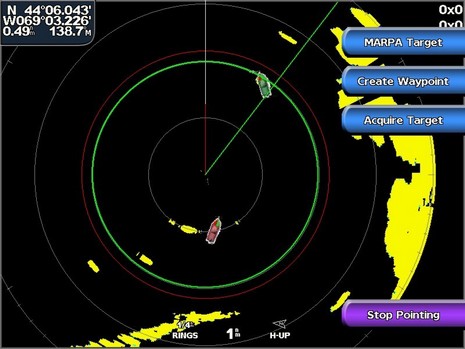



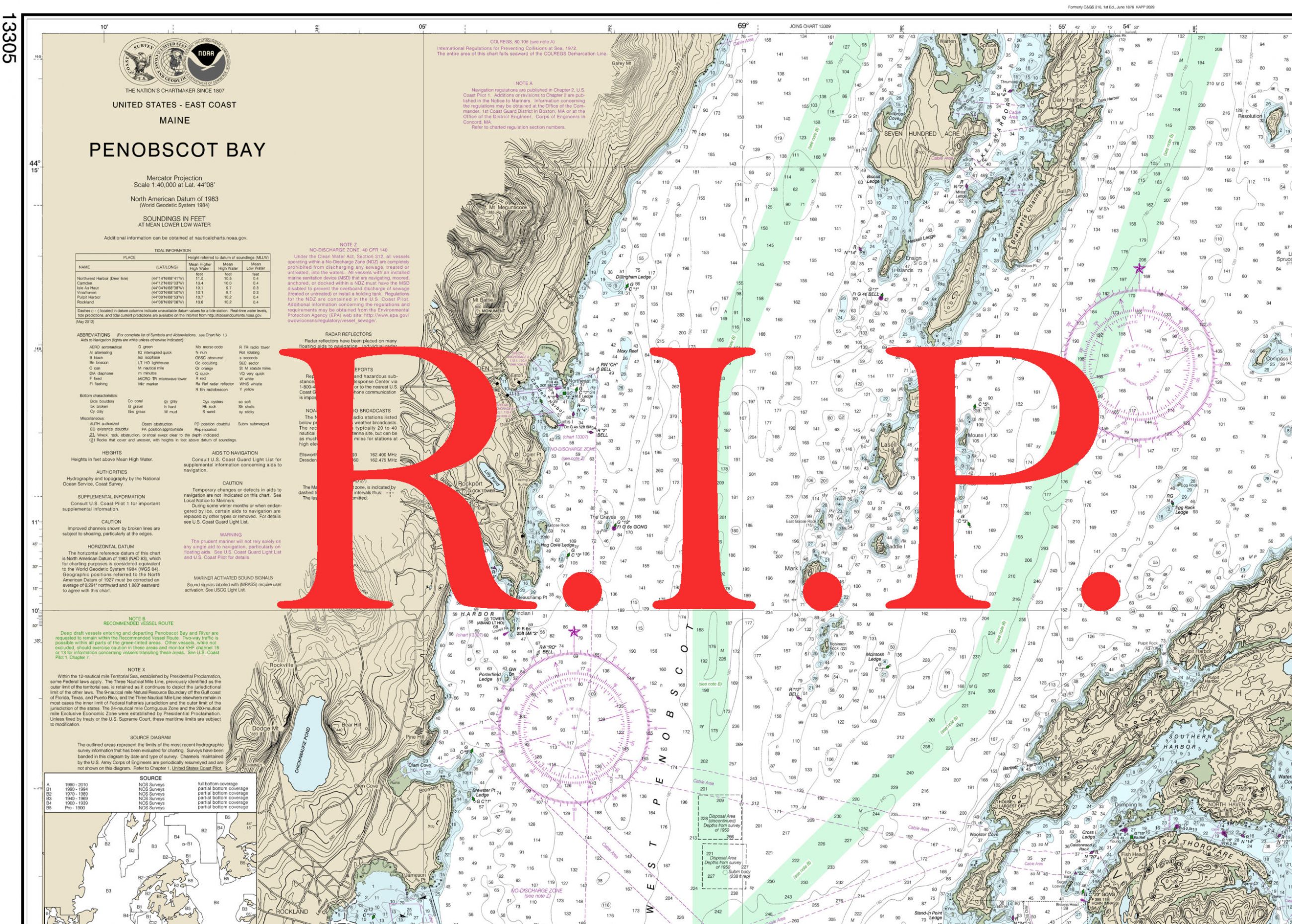
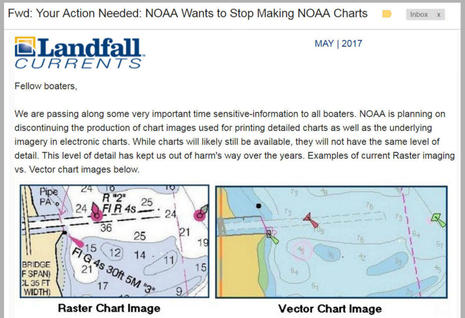
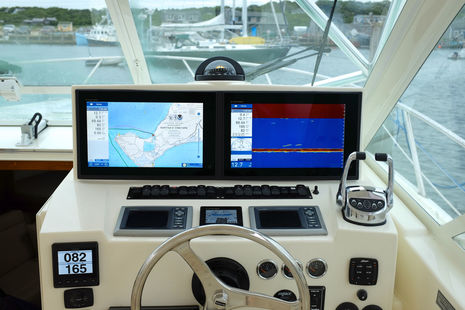






What I really like about the Garmin icons is they add to your situational awarness, especially at night, by giving you visual cues as to what type situation your in. You can look at the radar display see the navigation lights that are presented by the icons, and then validate what your seeing visual is the same as the radar is showing. Too many folks don’t know how to correlate radar track data by visual cues.
There will be a new online revision to the 4000/5000 MFD’s available in the next two weeks, along with another software update.
Tom
Tonka Toy Radars for Tonka Toy Boats with Tonka Toy Skippers!
I just installed a Garmin, GMR 24 HD radar on a Tashiba 40 with 4212 MFD. My first impression was the same as Ben’s. The radar targets all looked muddy in Northport Harbor, NY. The twenty year old Furuno 1800 looked stunning by comparison. Although I did not have the benefit of a Garmin Rep aboard I was able to clear up the target definition, just a little, by manually tuning. If I have to manually tune each time I use the radar does this mean the auto-tune feature is not up to the task yet? The horizontal beam width for the GMR 24 HD is 3.6 degrees so I wonder how much of the muddy target is associated with this specification. In my opinion, I would not exactly call this “High Definition” but the radar target overlay on the chart was perfect right out of the box. I really hope this is just a software issue because I love all the other features of the Garmin 4212.
That Garmin plotter display looks far too crowded! Tom, do you work for or represent Garmin?
Cranky guys! Wildfish, I don’t think the Garmin display is more crowded than others, and besides much can be customized on it. I’d like to see the a choice of smaller or alternate target icons, and maybe we will. Meanwhile, I’m pretty sure Tom is just a Garmin enthusiast, but one who’s done a lot to share his experience with others:
http://tinyurl.com/6bhlkh
As for Tonka Toy radars and skippers, well that’s just laughable! For one thing, the price of fuel is making the “small is beautiful” concept truer every day. For another, the owner of this particular boat happens to also captain Boeing 747s all over the globe. Maybe that’s why he doesn’t need a big swinging 6′ array to feel manly!
Does this HD radar only has a two level display (black or yellow)? I see a just hint of green.
I don’t understand the “overloaded with blotchy targets” comment. Most of the big blotch is land — are there too many targets otherwise? Too many would have to mean that it’s showing something that isn’t there, right?
The distance resolution looks poor. Radially, each target looks like 5 degrees, which would be right according to the spec. This is antenna physics, the relative size of the antenna and the wavelength. The only options for narrower beam width are a bigger antenna or a shorter wavelength. But the display could be improved with HD signal processing.
Two comments on the screen shot. Having your own boat at different heights on the two halves of the split screen doesn’t make it easy to compare targets. The chart/radar overlay on the left is too cluttered at this scale to be a good navigational tool. In my opinion.
What I would like to see is a chart/radar overlay system where I could very rapidly flip between chart, radar, and chart&radar. Not by going through lots of menus, but just by one button push or knob twist. Otherwise the comparison value is reduced. I tried a Garmin in-store demo and either I missed this or it wasn’t there.
Norse, the radar does show other colors, but I didn’t see enough of them to understand what they meant. The screen shot shown was take after we adjusted the unit’s gain. I think it’s a pretty fair radar image for an 18″ scanner, but it is at a scale that you wouldn’t necessarily use in that complex an area.
Note the little “1” icon lower right on the split screen (a “combination” in Garmin terms). Hit the related soft key, and the windows flip, so the overlay would become the bigger #1 window, plain radar the smaller #2 window. Also if you start using the cursor on the main window, it goes full screen. It’s pretty slick once you get the idea.
Why doesn’t Garmin say something about the features of their HD radars? I found this about NavNet 3D radar:
“True Color Radar Presentation shows target density in up to 16 color levels”
“Digitally enhanced beam width and side lobe reduction technology”
Ben,
Why isn’t the radar picking up the other green buoy at about 1 mile on the starboard side of the heading line? It might only have a 5 degree beamwidth but, it is supposed to be a 4kW transmitter. I would think it would easily pick up a bouy at one mile. It also looks very blocky for an HD radar as well.
I have an older Furuno dome radar that gets a better picture.
Roger
Beam width is a function of antenna physics, not transceiver physics, and is pretty much limited to the physical dimensions of the antenna versus wavelength. This isn’t a bad thing: after all, smaller vessels need/deserve the safety benefits of radar as much as larger vessels do.
I do wish the manufacturers’ marketing departments would kick this “HD” habit. It really is a meaningless term in this context – we’re only dealing with a fancy post-receiver video manipulation and display sophistication here – but now that they are on this kick, I suppose there will be further escalations before common sense ultimately returns.
I have not sailed in that harbor, so I have no personal experience to compare to. But to my eye, this display appears “choppy”, probably because of the many non-contiguous land masses.
On the other hand, I love the benefits of bright multi-color displays: how really easy it is to see the EBL/VRM, for example. And the simple small direction arrow above the display mode is a neat touch.
Presumably the boat icons with sidelight colors are only on the mini-Marpa display? If they are going to present sidelight colors, why wouldn’t they depict them sweeping back to the 112.5 degree arc? I also have an underlying suspicion of mini-Marpa because so many steps along the calculation path can introduce errors that result in a final inaccurate solution…for example, compass errors, knotmeter inaccuracies, etc. What about those other blips in the mini-Marpa screen shot? Are they vessels? What do the trails/wakes look like?
While the main concern for this display is at least in part due to the antenna beamwidth, the down range extent of every target is what really adds to the sense of “blotchy” appearance. Note that you cannot tell the difference between a bouy and a 45′ boat – the blotch for each is exactly the same. There are two ways to improve this picture – 1) Improve range resolution 2) Convert from Analog Video target detection to “HD”Analog to DIgital conversion without logrithmic analog detection.
The sad truth is that virtually all Marine radars are built by the same 2-3 companies. Japan Radio Company and Koden are the two best known who sell to most “branded” firms. Furuno and few others carry their own design. Nobeltec and Garmin and Raymarine all use branded radars built by the same suppliers. Each company adds its own display methods and software controls. It takes a huge investment to create an all new, truly landmark radar. So nearly all systems have the same signal processing that is limited in the same ways. Navnet 3D is a unique standout in this regard.
Consider that most radars have a minimum range resolution of about 35 – 50ft. That means a bouy looks as “long” as a 45ft trawler. When range goes beyond the first mile or so, the resolution only gets worse and within the first 3- 6 miles drops to 500ft per pixel for even the very best UHD radar. So now one blotch is 500ft long – whether the target is a bouy or a small cargo ship, the blotch on the display is the same.
All of this is true regardless if you have an 8ft open array or an 18″ array. Garmin and others have no business calling an 18″ radar “HD” for any reason. They may be doing some post processing to help sharpen the display a bit but really nothing has fundamentally changed in the range or angle resolution of the radar.
To evaluate your radar range resolution take the pulse length in microseconds and divide by 0.002 – that will be your range resolution in feet. So a 1 microsecond pulse (1 uSec) = 1/0.002 = 500ft. For the short pulses of 70 nSec = 0.07uSec/0.002 =35 ft.
So a 1000ft ship at 3 Nmi on many radars will have no more than 2 “pixels” or blotches to define its length – if you can see it all from end to end.
Now consider the resolution of the screen. For 1 Nmi range and 35ft range resolution there are just 6080 ft/ 35ft res = 173.7 “Pixels” of resolution but your display is 480 pixels high. So the target “pixel” of a bouy gets expanded by a factor of nearly 3:1 to make it match the screen size.
The real solution is for new radars to have range resolution that is dramatically reduced from the typical 35 – 500ft to numbers closer to 10 – 100ft depending on the range displayed on the screen. With 10ft resolution a bouy is one pixel and a 45ft trawler is 4 or 5 and a 500ft cargo ship has 50 pixels available. NOW you can distinguish details and target type.
Work on advanced radars with very high resolution is taking place and will appear some day soon. Until then – what passes as “HD” pales before what the next generation will provide. An old radar designer.
Wildfish ……
I do not work for or have any professional association with Garmin. I use Garmin products on my boat. I spent 31 years in the Navy in the combat systems area both as an installer/repair and as a user.
Tom
I am confused … how does a radar know the depth of a target … bouy, trawler, or cargo ship … if the physics of the whole thing is based on a reflection coming off the skin of the target facing you ?
Do these new radars use doppler shift to determine the movement of a target ?
Sounds like the “HD” description is laughable. Since there is noticable improvements in the post processing of the radar signal in my 18″ Raymarine radar, since I installed V4 software in my E-80 … does that make it HD ?
By the way … to the Hunter sailboat who almost collided with me in the fog 2 miles south of block island yesterday, and who was obviously assisted by radar detecting me … pls bone up on the navigation rules regarding actions to take when using radar in restricted visability … especially the one that reads “avoid course changes to port for a vessel ahead”. And to the FCC … when are we getting AIS ?? I had not realized how difficult it was to contact other boaters on VHF 16 when sailing in fog, getting the boats name on AIS would be alot simpler to get someone’s attention. Grumble.
How much better is the 18 HD version than the old 18?
Is it worth the extra money? You mentioned that HD was just hype (or something similar).
So far, I have been very pleased with my 5212.
Thanks
Ricky, I never said HD was “just hype.” I did complain that there are no standards to it, so you really don’t know what a particular manufacturer is doing until you test it.
I have not seen a Garmin non-HD 18″ in action, but suspect the HD is worth the fairly small price difference, even if it takes a while for Garmin engineers to get the most out of it.
Magnetron radars do not have a sufficiently stable transmitter pulse to be able to effectively sense doppler shift. Maggies are notorious for shifting frequency even within a single transmitter pulse, and for splattering wasted energy over a broad frequency spectrum. Doppler promises benefits that will come once the manufacturers ditch the maggie in favor of solid-state transmitters. I can envision several important benefits from doppler in this environment, but I suspect they are 5 or more years away.
As for depth of the target, you’re sort of right. Fundamentally, it’s “the larger the vessel, the larger the target”. Also, see Dave V’s excellent description above of pulse length and display limitations.
Larry has it nearly exactly right – Maggies typically cannot be used for Doppler and they do indeed cause problems with “splatter” of energy outside the desired band. So much so that Intl Maritime Org (IMO)and Intl Technical Union (ITU) are forcing Magnetron makers to reduce “spurious emissions”. Maggie days are limited by the advent of digitally synthesized waveforms and solid state transmitters that are perfectly coherent and very capable of doppler analysis.
WRT to Dan’s question about “skin reflection” from a ship – there are reflections from every surface on a ship with line of sight back to the radar – so if a radar can resolve the reflections in distance it can paint the object with many pixels. One way the 18″ antenna shows a large reflection is the large angle extent of the target – it has a WIDE appearance but no depth detail. It stays wide because the signal is so strong it continues to be detected at the edges of the antenna beamwidth and is therefore “extended”. The better HD radars have found ways to prevent this widening and extended azimuth extent to get a sharper image – that much is worthwhile, but none really can provide any better downrange or depth resolution.
Lastly – if you have an old maggie radar thats fine but be aware that maggies are tubes – and if you are old enough you know that tubes slowly fade over time. Maggie output power will drop very slowly then near the end of life (2000 – 3000 hours) fail more rapidly. So leaving your radar on constantly when not needed reduces life expectancy – unlike solidstate gear.
Dan, the loud hailer comes in handy for those Hunter close encounters. They may not see the special hand/finger signal in the fog when their radio is off but they will hear the special verbal signal…..
Ben, a comparison of the Furuno and Garmin 18″ HD domes would be an interesting read. I’m sure they sell way more of these than the big open arrays. Which means an article on the 18″ domes would be of specific concern to far more readers than the whiz bang stuff that most cannot afford to buy.
JB
Can the GMR 18HD be connected directly to the Garmin Marine Network backbone for display on a pc connected with a USB Actsense gateway?
Sorry, Mark, there is no PC program that can connect to the Garmin Marine Network for radar, charting, or sonar. And if there was, it would be an Ethernet connection. NMEA 2000 (and hence the related Actisense gateways) does not have enough bandwidth for radar, sonar, etc.
I do not work for or have any professional association with Garmin. I use Garmin products on my boat. I spent 31 years in the Navy in the combat systems area both as an installer/repair and as a user.
I have a Garmin 24HD, and I have been wildly underwhelmed by it.
Not so much for fine detail resolution, although that is nothing great, but for sea clutter issues.
It seems that a lot of the times I go fishing, it’s pretty messy out. As soon as the seas get choppy, I lose any near target resolution because the entire inside ring is cluttered with noise.
If I increase the sea clutter rejection, it clears up, BUT, it starts missing hard targets.
It’s very, very frustrating. I’d give Garmin a “C” at best at this point. I used to give it a “B”, but my frustrations have grown as I’ve had to run at night with no ambient light and a radar that won’t pick up high flyers or anything within an eighth to a quarter mile.
Don’t even get me started on the GSD22.